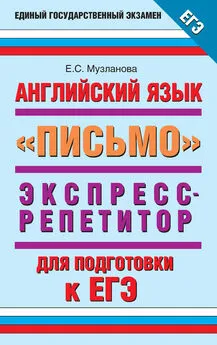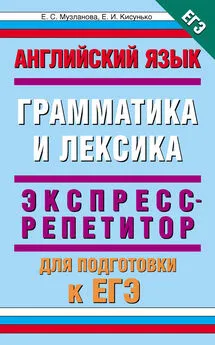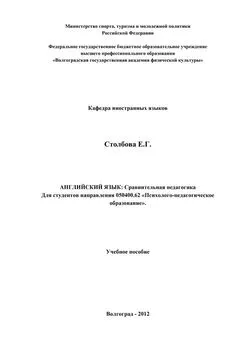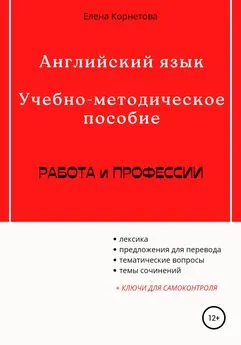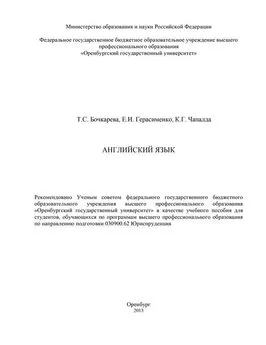Елена Беликова - Английский язык
- Название:Английский язык
- Автор:
- Жанр:
- Издательство:неизвестно
- Год:неизвестен
- ISBN:нет данных
- Рейтинг:
- Избранное:Добавить в избранное
-
Отзывы:
-
Ваша оценка:
Елена Беликова - Английский язык краткое содержание
Студенту без шпаргалки никуда! Удобное и красивое оформление, ответы на все экзаменационные вопросы ведущих вузов России.
Английский язык - читать онлайн бесплатно полную версию (весь текст целиком)
Интервал:
Закладка:
bone – кость
internal – внешний
phosphorus – фосфор
atrophy – атрофия
spongy – губчатый
tendon – сухожилие
ligament – связка
flexible – гибкий
periosteum – надкостница
osteoblast – остеобласт (клетка, образующая кость)
rigidity – неподвижность
shape – форма
to crumble – крошиться
to congregate – собираться
epiphyseal – относящийся к эпифизу
shaft – ствол, тело (длинной) кости, диафиз
14. Skull
Bones of the skull: the neurocranium (the portion of the skull that surrounds and protects the brain) or the viscerocra-nium (i. e., the skeleton of the face). Bones of the neurocranium Frontal, Parietal, Temporal, Occipital, Ethmoid, Sphenoid.
Bones of the viscerocranium (surface): Maxilla, Nasal, Zygomatic, Mandible. Bones of the viscerocranium (deep): Ethmoid, Sphenoid, Vomer, Lacrimal, Palatine, Inferior nasal concha. Articulations: Most skull bones meet at immovable joints called sutures. The coronal suture is between the frontal and the parietal bones The sagittal suture is between two parietal bones. The lambdoid suture is between the parietal and the occipital bones. The bregma is the point at which the coronal suture intersects the sagittal suture
The lambda is the point at which the sagittal suture intersects the lambdoid suture. The pterion is the point on the lateral aspect of the skull where the greater wing of the sphenoid, parietal, frontal, and temporal bones converge. The temporomandibular joint is between the mandibular fossa of the temporal bone and the condylar process of the mandible.
The parotid gland is the largest of the salivary glands. Structures found within the substance of this gland include the following: Motor branches of the facial nerve CN VII enters the parotid gland after emerging from the stylomastoid foramen at the base of the skull. Superficial temporal artery and vein. The artery is a terminal branch of the external carotid artery.
Retromandibular vein, which is formed from the maxillary and superficial temporal veins.
Great auricular nerve, which is a cutaneous branch of the cer vical plexus. Auriculotemporal nerve, which is a sensory branch of V3. It supplies the TMJ and conveys postganglionic parasympathetic fibers from the otic ganglion to the parotid gland Parotid (Stensen s) duct, which enters the oral cavity at the level of the maxillary second molar. The facial artery
is a branch of the external carotid artery in the neck. It
terminates as the angular artery near the bridge of the nose.
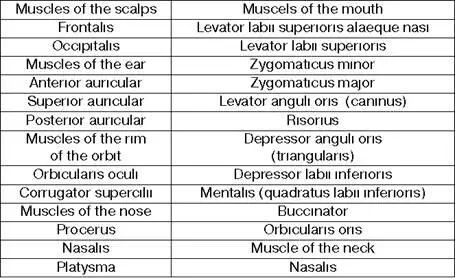
brain – мозг
frontal – лобная
parietal – теменная
temporal – височная
occipital – затылочная
ethmoid – решетчатая
maxilla – верхняя челюсть
zygomatic – скуловой
mandible – нижняя челюсть
sphenoid – клиновидная
vomer – сошник
lacrimal – слезная
palatine – небная
nasal concha – носовая раковина
15. Neck. Cervical vertebrae, cartilages, triangels
Cervical vertebrae: There are seven cervical vertebrae of which the first two are atypical. All cervical vertebrae have the foramina transversaria which produce a canal that transmits the vertbral artery and vein.
Atlas: This is the first cervical vertebra (C1). It has no body and leaves a space to accommodate the dens of the second cervical vertebra. Axis: This is the second cervical vertebra (C2). It has odontoid process, which articulates with the atlas as a pivot joint. Hyoid bone is a small U-shaped bone, which is suspended by muscles and ligaments at the level of vertebra C3.
Laryngeal prominence is formed by the lamina of the thyroid cartilage.
Cricoid cartilage. The arch of the cricoid is palpable below the thyroid cartilage and superior to the first tracheal ring (vertebral level C6). Triangles of the neck: The neck is divided into a posterior and an arterior triangle by the sternocleidomastoid muscle. These triangles are subdivided by smaller muscles into six smaller triangles. Posterior triangle is bound by the sternocleidomastoid, the clavicle, and the trapezius. Occipital triangle is located above the inferior belly of the omohyoid muscle. Its contents include the following: CN XI Cutaneous branches of the cervical plexus are the lesser occipital, great auricular, transverse cervical, and supaclavicular nerves.
Subclavian (omoclavicular, supraclavicular) triangle is located below the inferior belly of the omohyoid. Its contents include the following: Brachial plexus supraclavicular portion The branches include the dorsal scapular, long thoracic, subclavius, and suprascapular nerves.
The third part of the subclavian artery enters the subclavian triangle.
The subclavian vein passes superficial to scalenus anterior muscle. It receives the external jugular vein.
Anterior triangle is bound by the sternocleidomastoid muse the midline of the neck, and the inferior border of the body of the mandible. Muscular triangle is bound by the sternocleidomastoid muscle, the superior belly of the omohyoid muscle, and the midline of the neck. Carotid (vascular) triangle is bound by the sternocleidomastoid muscle, the superior belly of the omohyoid muscle and the posterior belly of the digastric muscle. The carotid triangle contains the following: Internal jugular vein; Common carotid artery, bifurcates and form the internal and external carotid arteries. The external carotid artery has six branches (i. e., the superior thyroid; the ascending pharyngeal, the lingual, the facial, the occipital, and the posterior auricular arteries). Vagus nerve; hypoglossal nerve; internal and external laryngeal branches of the superior laryngeal branch of the vagus nerve. Digastric (sub-mandibular) triangle is bound by the anterior and posterior bellies of the digastric muscle and the inferi or border of the body of the mandible. It contains the submandibular salivary gland. Submental triangle is bound by the anterior belly of the digastric muscle, the hyoid bone, and the midline of the neck. It contains the submental lymph nodes.
16. Neck. Root, fascies of the neck
Root of neck: This area communicates with the superior medi astinum through the thoracic inlet. Structures of the region include the following: subclavian artery and vein. The subclavian artery passes poste rior to the scalenus anterior muscle, and the vein passes ante rior to it Branches of the artery include: vertebral artery; thyrocervical trunk, which gives rise to the inferior thyroid, the transverse cervical, and the suprascapular arteries; Internal thoracic artery.
Phrenic nerve is a branch of the cervical plexus, which arises from C3, C4, and C5. It is the sole motor nerve to the diaphragm. It crosses the anterior scalene muscle from lateral to medial to enter the thoracic inlet.
Recurrent laryngeal nerve is a branch of the vagus nerve. This mixed nerve conveys sensory information from the laryngeal; mucosa below the level of the vocal folds and provides motor innervation to all the intrinsic muscles of the larynx except the cricothyroid muscle.
Thoracic duct terminates at the junction of the left subclavian and the left internal jugular veins On the right side of the body, the right lymphatic duct terminates in a similar fashion.
Fascias of the neck Superficial investing fascia encloses the platysma, a muscle of facial expression, which has migrated to the neck
Deep investing fascia surrounds the trapezius and ster-noclei – domastoid muscles.
Retropharyngeal (visceral) fascia surrounds the pharynx.
Prevertebral fascia invests the prevertebral muscles of the nee (i. e., longus colli, longus capitis) This layer gives rise to a derivative known as the alar fascia.
The major muscle groups and their innervations. A simple method of organizing the muscles of the neck is based on two basic principles: (1) The muscles may be arranged in group according to their functions; and (2) all muscles in a group share common innervation with one exception in each group.
Group 1: Muscles of the tongue. All intrinsic muscles plus all but one of the extrinsic muscles (i. e., those containing the suffix, glossus) of the tongue are supplied by CN XII. The one exception is palatoglossus, which is supplied by CN X.
Group 2: Muscles of the larynx. All but one of the intrinsic muscles of the larynx are supplied by the recurrent la-ryngeal branch of the vagus nerve. The sole exception is the cricothyroid muscle, which is supplied by the external laryngeal branch of the vagus.
Group 3: Muscles of the pharynx. All but one of the longitudinal and circular muscles of the pharynx are supplied by CNs X and XI (cranial portion). The sole exception is the stylopharyngeus muscle, which is supplied by CN IX.
Group 4: Muscles of the soft palate. All but one of the muscles of the palate are supplied by CNs X and XI (cranial portion). The sole exception is the tensor veli palatini, which is supplied CN V3.
Group 5: Infrahyoid muscles. All but one of the infrahyo-id muscles are supplied by the ansa cervicalis of the cervical olexus (C1, C2, and C3). The exception is the thy-rohyoid, which is supplied by a branch of C1. (This branch of C1 also supplies the geniohyoid muscle).
neck – шея
cervical – цервикальный
vertebrae – позвоночник
cricoid cartilage – перстневидный хрящ гортани
scapulae – лопатка
scalene – лестничная мышца
brachial plexus – плечевое сплетение
vagus nerve – блуждающий нерв
hypoglossal nerve – подъязычный нерв
laryngeal branches – гортанные ветви
17. Thoracic wall
There are 12 thoracic vertebrae. Each rib articulates with the body of the numerically corresponding vertebra and the one below it. Sternum: the manubrium articulates with the clavicle and the first rib. It meets the body of the sternum at the sternal angel an important clinical landmark.
The body articulates directly with ribs 2–7; it articulates interiorly with the xiphoid process.
Ribs and costal cartilages: there are 12 pairs of ribs, which are attached posteriorly to thoracic vertebrae.
Ribs 1–7 attach directly to the sternum by costal cartilages.
Ribs 8 – 10 attach to the costal cartilage of the rib above. Ribs 11 and 12 have no anterior attachments. The costal groove is located along the inferior border of each rib and provides protection for the intercostal nerve artery, and vein.
There are 11 pairs of external intercostal muscles.
These muscles fill the intercostal spaces from the tubercles of ribs posteriorly to the costochondral junctions anteriorly. There are 11 pairs of internal intercostal muscles.
These muscles fill the intercostal spaces anteriorly from the sternum to the angles of the ribs posteriorly.
Innermost intercostal muscles: the deep layers of the internal intercostal muscles are the innermost intercostal muscles.
Читать дальшеИнтервал:
Закладка:



